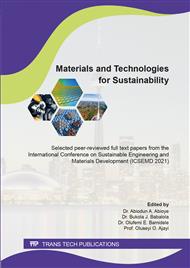[1]
S.C. Nwanya, J.I. Udofia, O.O. Ajayi, Optimization of machine downtime in the plastic manufacturing, Cogent Engineering. 4, 1 (2017) 1335444.
DOI: 10.1080/23311916.2017.1335444
Google Scholar
[2]
A. S. H. Makhlouf, M. A. Botello, Failure of the metallic structures due to microbiologically induced corrosion and the techniques for protection, In Handbook of Materials Failure Analysis (2018) 1-18 Butterworth-Heinemann.https://doi.org/10.1016/B978-0-08-101928-3.00001-X.
DOI: 10.1016/b978-0-08-101928-3.00001-x
Google Scholar
[3]
M. J. Rahimdel, M. Ataei, B. Ghodrati, Modeling and simulation approaches for reliability analysis of drilling machines, Journal of The Institution of Engineers (India): Series C. 101,1 (2020) 125-133.
DOI: 10.1007/s40032-019-00533-x
Google Scholar
[4]
X. Zhou, Z. Hu, Y. Tao, X. Qin, L. Hua, Failure mechanisms and structural optimization of shredder hammer for metal scraps, Chinese Journal of Mechanical Engineering. 29, 4 (2016) 792-801.
DOI: 10.3901/cjme.2016.0415.053
Google Scholar
[5]
K. C. Chang, J. R. Zhao, F. Y. Hung, Microstructure, mechanical properties, and fatigue fracture characteristics of high-fracture-resistance selective laser melting Al-Ni-Cu alloys, Metals. 11,1 (2021) 87. 10.3390/met11010087.
DOI: 10.3390/met11010087
Google Scholar
[6]
P. Sahoo, K. Patra, On stability analysis for micro milling of P-20 steel: Enhancement through application of TiAlN coated WC tool, Materials Today: Proceedings. (2020).
DOI: 10.1016/j.matpr.2019.12.312
Google Scholar
[7]
J. Lee, I. Cameron, M. Hassall, Improving process safety: What roles for digitalization and industry 4.0?. Process safety and environmental protection. 132 (2019) 325-339. https://doi.org/10.1016/j.psep.2019.10.021.
DOI: 10.1016/j.psep.2019.10.021
Google Scholar
[8]
B. Garmeh, M. Kasiri-Asgarani, K., Amini, H. Ghayour, Analysis of hadfield scrap shredder hammer fracture and replacing it with carbide-free nano-bainitic steel, Engineering Failure Analysis. 109 (2020) 104230. doi.org/10.1016/j.engfailanal.2019.104230.
DOI: 10.1016/j.engfailanal.2019.104230
Google Scholar
[9]
P. Sahoo, K. Patra, On stability analysis for micro milling of P-20 steel: Enhancement through application of TiAlN coated WC tool, Materials Today: Proceedings. (2020).
DOI: 10.1016/j.matpr.2019.12.312
Google Scholar
[10]
S. E. Yekini, I. P. Okokpujie, S. A. Afolalu, O. O. Ajayi, J. Azeta, Investigation of production output for improvement, International Journal of Mechanical and Production Engineering Research and Development. 8, 1 (2018) 915-922.
DOI: 10.24247/ijmperdfeb2018111
Google Scholar
[11]
L. Tan, C. Yao, D. Zhang, J. Ren, Z. Zhou, J. Zhang, Evolution of surface integrity and fatigue properties after milling, polishing, and shot peening of TC17 alloy blades, International Journal of Fatigue. (2020) 105630.
DOI: 10.1016/j.ijfatigue.2020.105630
Google Scholar
[12]
G. Totis, T. Insperger, M. Sortino, G. Stépán, Symmetry breaking in milling dynamics, International Journal of Machine Tools and Manufacturer. 139, (2019) 37-59.
DOI: 10.1016/j.ijmachtools.2019.01.002
Google Scholar
[13]
R. Akinoso, I. Balogun, A. Alaka, Elucidating Energy Requirements for Size Reduction of Malted Maize, Soybean and Sorghum Milling Using Attrition Mill, Energy Conversion and Management: X. (2021) 100100. https://doi.org/10.1016/j.ecmx.2021.100100.
DOI: 10.1016/j.ecmx.2021.100100
Google Scholar
[14]
P. H. Selle, H. H. Truong, A. Khoddami, A. F. Moss, T. H. Roberts, S. Y. Liu, The impacts of hammer-mill screen size and grain particle size on the performance of broiler chickens offered diets based on two red sorghum varieties, British poultry science. 60,3(2019) 209-218.
DOI: 10.1080/00071668.2016.1257777
Google Scholar
[15]
H. M. Eldessouky, J. M. Flynn, S. T. Newman, On-machine error compensation for right first time manufacture, Procedia Manufacturing, 38, (2019) 1362-1371.
DOI: 10.1016/j.promfg.2020.01.152
Google Scholar
[16]
D. Levashkin, P. Ogin, F. Vasilyev, Efficiency of hybrid cyclic processing with the use of additive technologies on CNC machines for the manufacture of composite aviation parts due to the reduction of processing errors, In Materials Science Forum 946 (2019) 959-965. Trans Tech Publications Ltd.
DOI: 10.4028/www.scientific.net/msf.946.959
Google Scholar
[17]
S.C. Cha, H.J. Park, L.J. Han, K.K. Yool, C. H. Shin, Exploring the Effectiveness of a Complex Coating Technique for Use the Smallest Parts of Advanced Powertrain Fuel System, International Journal of Automotive Technology. 21, 3(2020) 667-673.
DOI: 10.1007/s12239-020-0064-1
Google Scholar
[18]
M. A. Butt, Y. Yang, X. Pei, Q. Liu, Five-axis milling vibration attenuation of freeform thin-walled part by eddy current damping, Precision Engineering. 51(2018) 682-690.
DOI: 10.1016/j.precisioneng.2017.11.010
Google Scholar
[19]
C. Hopkins, A. Hosseini, A Review of Developments in the Fields of the Design of Smart Cutting Tools, Wear Monitoring, and Sensor Innovation, IFAC-PapersOnLine. 52, 10 (2019) 352-357.
DOI: 10.1016/j.ifacol.2019.10.056
Google Scholar
[20]
M. Alghamdy, R. Ahmad, B. Alsayyed, Material selection methodology for additive manufacturing applications, Procedia CIRP. 84 (2019) 486-490.
DOI: 10.1016/j.procir.2019.04.265
Google Scholar
[21]
A. Bahri, N. Guermazi, K. Elleuch, M. Urgen, On the erosive wear of 3041 stainless steel caused by olive seed particles impact modelling and experiments, Tribol Int. (2016) 102.
DOI: 10.1016/j.triboint.2016.06.020
Google Scholar
[22]
I. Cotabarren, M. P. Fernández, A. Di Battista, J Piña, Modeling of maize breakage in hammer mills of different scales through a population balance approach. Powder Technology, 375 (2020) 433-444. https://doi.org/10.1016/j.powtec.2020.08.016.
DOI: 10.1016/j.powtec.2020.08.016
Google Scholar
[23]
A. Cinitha, V. Sampath, K. Kesavan, Strain monitoring of low carbon steel in a corrosive environment using fiber Bragg technology, Construction and Building Materials. 217 (2019) 265-272.
DOI: 10.1016/j.conbuildmat.2019.05.017
Google Scholar
[24]
A. Mishra, C. K. Behera, S. Mohan, A. Mohan, High Temperature erosion behaviour of Type AISI 446 stainless steel under the combined effect of surface modification and pre hot-corrosion, Engineering Failure Analysis. (2020) 104873.
DOI: 10.1016/j.engfailanal.2020.104873
Google Scholar
[25]
V. D. Kalyankar, G. Chudasama, Effect of post weld heat treatment on mechanical properties of pressure vessel steels, Materials Today: Proceedings. 5, 11 (2018) 24675-24684.
DOI: 10.1016/j.matpr.2018.10.265
Google Scholar
[26]
F. Piechnicki, C. F. Dos Santos, E. De Freitas Rocha Loures, E. A. P. Dos Santos, Data fusion framework for decision-making support in reliability-centered maintenance, Journal of Industrial and Production Engineering. 38,1 (2021) 1-17.
DOI: 10.1080/21681015.2020.1817164
Google Scholar
[27]
S. Okwuobi, F. Ishola, O. Ajayi, E. Salawu, A. Aworinde, O. Olatunji, S.A. Akinlabi, A Reliability-Centered Maintenance Study for an Individual Section-Forming Machine, Machines, 6,4 (2018) 50.
DOI: 10.3390/machines6040050
Google Scholar


